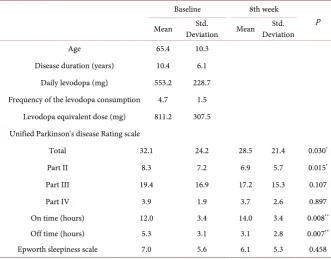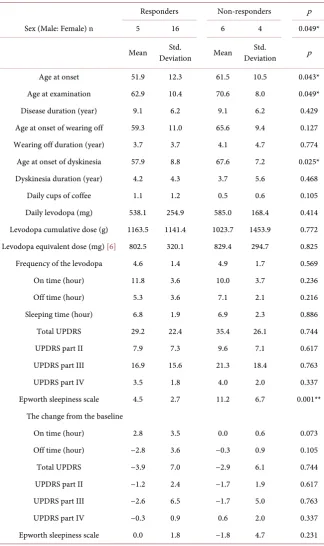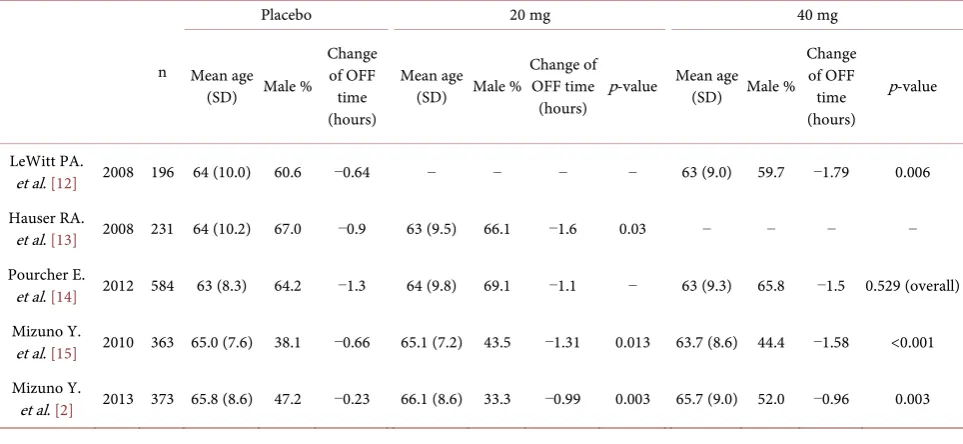http://www.scirp.org/journal/apd ISSN Online: 2169-9720
ISSN Print: 2169-9712
Differences between Istradefylline Responders
and Non-Responders in Parkinson’s Disease
Asako Yoritaka
1, Nobutaka Hattori
21Department of Neurology, Juntendo University Koshigaya Hospital, Saitama, Japan 2Department of Neurology, Juntendo University School of Medicine, Tokyo, Japan
Abstract
Background: Istradefylline is a selective adenosine A2A receptor antagonist approved for Parkinson’s disease (PD) patients with wearing-off symptoms. The Japanese phase III trial showed that 20 mg of orally administrated istra-defylline decreased the Off-time. However, istraistra-defylline showed prominent effects in some patients and no benefits in others. We examined the differ-ences in characteristics between responders and non-responders who received 8 weeks of 20 mg/day istradefylline. Methods: Thirty-one patients were en- rolled (age, 65.4 [SD 10.4] years; disease duration, 10.4 [SD 6.1] years; daily levodopa dosage, 553.2 [SD 228.7] mg; frequency of levodopa consumption, 4.7 [SD 1.5] times; levodopa equivalent dose, 811.2 [SD 307.5] mg). Results: There were significant differences (p < 0.05) in sex (male/female: 5/16, 6/4), age (62.9 (SD 10.4), 70.6 (SD 8.0) years), age at onset (51.9 (SD 12.3), 61.5 (SD 10.5) years old), age at dyskinesia onset (57.9 (SD 8.8), 67.6 (SD 7.2), and Ep-worth sleepiness scale scores (4.5 (SD 2.7), 11.2 (SD 6.7), p < 0.01) for the responders and non-responders, respectively. There were no differences in disease duration, On-time, Off-time, Unified Parkinson’s disease Rating scale scores, daily levodopa dose, levodopa equivalent dose, cumulative levodopa dose, or coffee intake. Conclusions: Younger or female patients who are not excessively sleepy during daytime are better candidates for the istradefylline therapy.
Keywords
Parkinson’s Disease, Istradefylline, Adenosine A2A Receptor Antagonist, Wearing-Off, Sleepiness
1. Introduction
Current treatments for Parkinson’s disease (PD) are based on dopamine re-placement therapy, including L-3, 4-dihydroxyphenylalnine (levodopa, L-DOPA), How to cite this paper: Yoritaka, A. and
Hattori, N. (2017) Differences between Istra- defylline Responders and Non-Responders in Parkinson’s Disease. Advances in Parkin- son’s Disease, 6, 45-51.
https://doi.org/10.4236/apd.2017.62005
Received: February 10, 2017 Accepted: March 28, 2017 Published: March 31, 2017
Copyright © 2017 by authors and Scientific Research Publishing Inc. This work is licensed under the Creative Commons Attribution International License (CC BY 4.0).
http://creativecommons.org/licenses/by/4.0/
dopamine agonists (DA), monoamine oxidase B inhibitors (MAOB-I), and ca-thechol-O-methyltransferase inhibitors (COMT-I). Istradefylline is a selective antagonist of the adenosine A2A receptor, and has been approved for use in PD with regard to anti-parkinsonian effects in patients with wearing-off symptoms
[1]. A recent phase III trial demonstrated that the oral administration of istrade-fylline (20 mg) reduced off time in patients, while 40 mg of istradeistrade-fylline im-proved part III of the Unified Parkinson’s disease Rating scale (UPDRS) during on-phase [2]. However, the clinical results were inconsistent. While istradefyl-line demonstrated prominent effects in a number of patients; others experienced little or no benefit. Therefore, to elucidate the epidemiological differences be-tween istradefylline responders and non-responders, a retrospective analysis was performed.
2. Methods and Materials
2.1. Patients
Patients with PD were recruited according to the following specifications: 1) pa-tients were diagnosed on the basis of the UK PD Brain Bank criteria [3]; 2) pa-tients were medicated with levodopa and experienced wearing off; 3) papa-tients featured a rating between 0 and 4 on the modified Hoehn and Yahr (H&Y) scale during the on-phase; and 4) patients wanted to reduce their off-phase disability and received 20 mg/day of istradefylline once in the morning in A.Y.’s outpa-tient clinic at the Juntendo University Koshigaya hospital between October 2013 and October 2015. Participants were excluded based on the following criteria: 1) patients experienced Parkinsonism due to diseases other than PD; 2) patients were diagnosed with other serious diseases, malignant tumors, or adverse events caused by drugs. All patients provided informed consent prior to the data collec-tion. This study was approved by the Juntendo Koshigaya Hospital Institutional Ethics Committee.
2.2. Evaluations
Upon initiation of istradefylline (baseline) treatment and after the 8th week visit, patients were examined according to the UPDRS [4], Epworth sleepiness scale (ESS), [5] on time and off time, and sleeping time, which were recorded in an on/off hourly diary for one week. Responders were evaluated according to the criteria: “very much improved,” “much improved,” and “minimally improved,” while non-responders were defined as “no change” and “worsened” using the Patients Global Impression of Improvement.
2.3. Statistical Analysis
We compared the two groups by using either t-test or χ2-test using SPSS (Version 20.0). Two-sided statistical tests were used and the significance level was set at 0.05.
3. Results
Table 1. Patient characteristics at baseline and the 8th week.
Baseline 8th week
p Mean Deviation Mean Std. Deviation Std.
Age 65.4 10.3
Disease duration (years) 10.4 6.1 Daily levodopa (mg) 553.2 228.7 Frequency of the levodopa consumption 4.7 1.5
Levodopa equivalent dose (mg) 811.2 307.5 Unified Parkinson's disease Rating scale
Total 32.1 24.2 28.5 21.4 0.030*
Part II 8.3 7.2 6.9 5.7 0.015*
Part III 19.4 16.9 17.2 15.3 0.107
Part IV 3.9 1.9 3.7 2.6 0.897
On time (hours) 12.0 3.4 14.0 3.4 0.008**
Off time (hours) 5.3 3.1 3.1 2.8 0.007**
Epworth sleepiness scale 7.0 5.6 6.1 5.3 0.458 *p < 0.05, **p < 0.01.
are displayed in Table 1. Istradefylline significantly increased On-time (p < 0.01), and decreased Off-time (p < 0.01), total UPDRS (p < 0.05), and UPDRS part II (p < 0.05) in patients with PD associated motor complications. Twenty one patients were responsive to istradefylline, while 10 patients did not demon-strate any therapeutic benefit. One patient who experienced auditory hallucina-tions was included in the non-responder group. The dyskinesia severity score (UPDRS) increased from 1 to 2 in several of the responders (n = 2). Other res-ponders experienced slight euphoria (n = 2). Subsequent analysis identified sig-nificant differences in the baseline characteristics of responders (n = 21) and non-responders (n = 10) with regard to sex, age, age at onset, age at dyskinesia onset, and ESS (Table 2). No differences were detected in disease duration or daily levodopa dosage. The ESS of non-responders was improved by istradefyl-line treatment, but was not significant. Regression analysis of changes in On- or Off-time did not indicate any correlations, and logistic regression analysis dem-onstrated that the odds ratio for non-responders was 1.519 (95% confidence in-terval 1.021 - 2.261, p = 0.039) in ESS. No correlation was detected between the effects of istradefylline and the therapeutic combination of DA, COMT-I, selegi-line, and zonisamide. In the non-responder group, with the exception of one pa-tient with hallucinations, no improvements were detected after istradefylline treatment with 40 mg.
4. Discussion
Table 2. Clinical differences of responders and non-responders to istradefylline.
Responders Non-responders p
Sex (Male: Female) n 5 16 6 4 0.049*
Mean Deviation Std. Mean Deviation Std. p
Age at onset 51.9 12.3 61.5 10.5 0.043*
Age at examination 62.9 10.4 70.6 8.0 0.049*
Disease duration (year) 9.1 6.2 9.1 6.2 0.429
Age at onset of wearing off 59.3 11.0 65.6 9.4 0.127 Wearing off duration (year) 3.7 3.7 4.1 4.7 0.774 Age at onset of dyskinesia 57.9 8.8 67.6 7.2 0.025* Dyskinesia duration (year) 4.2 4.3 3.7 5.6 0.468
Daily cups of coffee 1.1 1.2 0.5 0.6 0.105
Daily levodopa (mg) 538.1 254.9 585.0 168.4 0.414 Levodopa cumulative dose (g) 1163.5 1141.4 1023.7 1453.9 0.772 Levodopa equivalent dose (mg) [6] 802.5 320.1 829.4 294.7 0.825 Frequency of the levodopa 4.6 1.4 4.9 1.7 0.569
On time (hour) 11.8 3.6 10.0 3.7 0.236
Off time (hour) 5.3 3.6 7.1 2.1 0.216
Sleeping time (hour) 6.8 1.9 6.9 2.3 0.886
Total UPDRS 29.2 22.4 35.4 26.1 0.744
UPDRS part II 7.9 7.3 9.6 7.1 0.617
UPDRS part III 16.9 15.6 21.3 18.4 0.763
UPDRS part IV 3.5 1.8 4.0 2.0 0.337
Epworth sleepiness scale 4.5 2.7 11.2 6.7 0.001** The change from the baseline
On time (hour) 2.8 3.5 0.0 0.6 0.073
Off time (hour) −2.8 3.6 −0.3 0.9 0.105
Total UPDRS −3.9 7.0 −2.9 6.1 0.744
UPDRS part II −1.2 2.4 −1.7 1.9 0.617
UPDRS part III −2.6 6.5 −1.7 5.0 0.763
UPDRS part IV −0.3 0.9 0.6 2.0 0.337
Epworth sleepiness scale 0.0 1.8 −1.8 4.7 0.231 UPDRS: Unified Parkinson’s disease Rating scale, *p < 0.05, **p < 0.01.
regard to disease duration, daily or cumulative levodopa dose, duration of base-line On- or Off-time, or the age at the onset of wearing off. In addition, no dif-ferences were detected in the duration of dyskinesia between the two groups; however, the onset of dyskinesia was earlier than that of wearing off in respond-ers. This might relate to the increase in putamen adenosine A2A receptors ob-served in PD patients with dyskinesia [7].
Caffeine is an adenosine A2A antagonist that induces wakefulness via pre ade-nosine A2A receptors [8]. In the present study, the level of sleepiness correlated with the effects of istradefylline; therefore, patients who maintain sleep control might be suitable for istradefylline therapy.
Patients with PD demonstrate adenosine A2A receptor up-regulation in lym-phocyte membranes compared to healthy subjects [9]. No differences in A2A re-ceptor parameters were detected in relation to age, age at onset, or disease dura-tion strata. Patients with a greater density of A2A receptors were more likely to experience motor complications [9]. In the present study, earlier onset of dyski-nesia correlated with the effectiveness of istradefylline; however, the duration of dyskinesia was unrelated. Accordingly, the daily levodopa dose, levodopa equiv-alent dose, and the levodopa cumulative dose were not linked to the effectiveness of the adenosine A2A antagonist istradefylline in this study.
[image:5.595.58.540.521.743.2]Previous studies did not identify increased responsiveness to istradefylline in female patients with PD. The adenosine A2A receptor antagonist ATL 444 dem-onstrated reduced sensitivity in male compared to female rats [10]. However, the mechanisms underlying sex-related differences in adenosine A2A receptor sensi-tivity were not identified, although ovarian hormones are reported to increase the sensitivity of the D2/A2A receptor system in females [11]. The efficacy on the reduction of daily Off-time shown in four of the five randomized controlled, double blinded, multicenter trials (Table 3) [12][13][14][15]. A Japanese phase III trial that included more female subjects than the western trial demonstrated
Table 3. Off-time change from baseline of the randomized multicenter trials of Istradefylline.
n
Placebo 20 mg 40 mg
Mean age (SD) Male %
Change of OFF time (hours)
Mean age (SD) Male %
Change of OFF time
(hours) p-value
Mean age (SD) Male %
Change of OFF time (hours)
p-value
LeWitt PA.
et al. [12] 2008 196 64 (10.0) 60.6 −0.64 − − − − 63 (9.0) 59.7 −1.79 0.006 Hauser RA.
et al. [13] 2008 231 64 (10.2) 67.0 −0.9 63 (9.5) 66.1 −1.6 0.03 − − − − Pourcher E.
et al. [14] 2012 584 63 (8.3) 64.2 −1.3 64 (9.8) 69.1 −1.1 − 63 (9.3) 65.8 −1.5 0.529 (overall) Mizuno Y.
et al. [15] 2010 363 65.0 (7.6) 38.1 −0.66 65.1 (7.2) 43.5 −1.31 0.013 63.7 (8.6) 44.4 −1.58 <0.001 Mizuno Y.
a reduction in daily Off-time in the istradefylline group [2]. In a western Phase III trial, KW-6002-US-018, a reduction in Off-time was −1.3 hours in the place-bo group, and it was −1.1 hours in the 20 mg of istradefylline group [14], and their baseline characteristics were similar to the present study, excluding those regarding race and sex. Although, other two Western studies including the same ratio of sex, showed the efficacy on the reduction of Off-time [12][13] (Table 3).
This study featured several limitations. Primarily, the present study featured a small population; therefore, a larger study will be required to validate these re-sults. Second, this was an open study, and it was not possible to rule out the pla-cebo effect. In addition, the previous Japanese phase III trial revealed a 0.28 h increase in On-time, and a 0.23 h reduction in Off-time in the placebo group, therefore, additional effects need to be explored to elucidate this [2]. The placebo effects in female subjects are described in one report, which stated that female subjects with both lower dispositional anxiety and cortisol levels showed the largest vasopressin-induced modulation of placebo effects [16]. However, Shetty et al. analyzed the placebo effects in PD from 22 reports and a DATATOP study and found no correlation with age and gender [17]. In addition, Goetz et al. re-ported that gender, age, disease duration, and baseline disability score did not influence the likelihood of improvement in association with placebo treatment
[18].
5. Conclusion
In summary, our results cannot deny placebo effects; however, this study sug-gests that younger or female patients who are not excessively sleepy during the daytime are better candidates for istradefylline therapy.
References
[1] Mori, A. and Shindou, T. (2003) Modulation of GABAergic Transmission in the Striatopallidal System by Adenosine A2A Receptors: A Potential Mechanism for the
Antiparkinsonian Effects of A2A Antagonists. Neurology, 61, S44-S48. https://doi.org/10.1212/01.WNL.0000095211.71092.A0
[2] Mizuno, Y. and Kondo, T., Japanese Istradefylline Study Group (2013) Adenosine A2A Receptor Antagonist Istradefylline Reduces Daily OFF Time in Parkinson’s
Disease. Movement Disorders, 28, 1138-1141. https://doi.org/10.1002/mds.25418
[3] Hughes, A.J., Daniel, S.E., Kilford, L. and Lees, A.J. (1992) Accuracy of Clinical Di-agnosis of Idiopathic Parkinson’s Disease: A Clinico-Pathological Study of 100 Cas-es. Journal of Neurology, Neurosurgery & Psychiatry, 55, 181-184.
https://doi.org/10.1136/jnnp.55.3.181
[4] Fahn, S. and Elton, R., Members of the UPDRS Development Committee (1987) In: Fahn, S., Marsden, C.D., Calne, D.B. and Goldstein, M., Eds., Recent Developments in Parkinson’s Disease, Vol. 2, Macmillan Healthcare Information, Florham Park, 153-163.
[5] Johns, M.W. (1991) A New Method for Measuring Daytime Sleepiness: The Ep-worth Sleepiness Scale. Sleep, 14, 540-545.
Sys-tematic Review of Levodopa Dose Equivalency Reporting in Parkinson’s Disease.
Movement Disorders, 25, 2649-2653. https://doi.org/10.1002/mds.23429
[7] Mishina, M., Ishiwata, K., Naganawa, M., Kimura, Y., Kitamura, S., Suzuki, M., Mishina, M., Ishiwata, K., Naganawa, M., Kimura, Y. and Kitamura, S. (2011) Ade-nosine A2A Receptors Measured with [11C]TMSX PET in the Striata of Parkinson’s
Disease Patients. PLoS ONE, 6, e17338.
https://doi.org/10.1371/journal.pone.0017338
[8] Huang, Z.L., Qu, W.M., Eguchi, N., Chen, J.F., Schwarzschild, M.A., Fredholm, B.B., Urade, Y. and Hayaishi, O. (2005) Adenosine A2A, but Not A1, Receptors
Me-diate the Arousal Effect of Caffeine. Nature Neuroscience, 8, 858-859.
https://doi.org/10.1038/nn1491
[9] Casetta, I., Vincenzi, F., Bencivelli, D., Corciulo, C., Gentile, M., Granieri, E., Borea, P.A. and Varani, K. (2014) A2A Adenosine Receptors and Parkinson’s Disease
Se-verity. Acta Neurologica Scandinavica, 129, 276-281.
https://doi.org/10.1111/ane.12181
[10] Doylea, S.E., Breslina, F.J., Riegerb, J.M., Beaugleholeb, A. and Lyncha, W.J. (2012) Time and Sex-Dependent Effects of an Adenosine A2A/A1 Receptor Antagonist on
Motivation to Self-Administer Cocaine in Rats. Pharmacology Biochemistry and Behavior, 102, 257-263.
[11] Bazzett, T.J. and Becker, J.B. (1994) Sex Differences in the Rapid and Acute Effects of Estrogen on Striatal D2 Dopamine Receptor Binding. Brain Research, 637, 163- 172.
[12] LeWitt, P.A., Guttman, M., Tetrud, J.W., Tuite, P.J., Mori, A., Chaikin, P. and Sussman, N.M., 6002-US-005 Study Group (2008) Adenosine A2A Receptor
Anta-gonist Istradefylline (KW-6002) Reduces “off” Time in Parkinson’s Disease: A Dou- ble-Blind, Randomized, Multicenter Clinical Trial (6002-US-005). Annals of Neu-rology, 63, 295-302. https://doi.org/10.1002/ana.21315
[13] Hauser, R.A., Shulman, L.M., Trugman, J.M., Roberts, J.W., Mori, A., Ballerini, R. and Sussman, N.M., Istradefylline 6002-US-013 Study Group (2008) Study of Istra-defylline in Patients with Parkinson’s Disease on Levodopa with Motor Fluctua-tions. Movement Disorders, 23, 2177-2185. https://doi.org/10.1002/mds.22095
[14] Pourcher, E., Fernandez, H.H., Stacy, M., Mori, A., Ballerini, R. and Chaikin, P. (2012) Istradefylline for Parkinson’s Disease Patients Experiencing Motor Fluctua-tions: Results of the KW-6002-US-018 Study. Parkinsonism and Related Disorders, 18, 178-184. https://doi.org/10.1016/j.parkreldis.2011.09.023
[15] Mizuno, Y., Hasegawa, K., Kondo, T., Kuno, S. and Yamamoto, M., The Japanese Istradefylline Study Group (2010) Clinical Efficacy of Istradefylline (KW-6002) in Parkinson’s Disease: A Randomized, Controlled Study. Movement Disorders, 25, 1437-1443. https://doi.org/10.1002/mds.23107
[16] Colloca, L., Pine, D.S., Ernst, M., Miller, F.G. and Grillon, C. (2016) Vasopressin Boosts Placebo Analgesic Effects in Women: A Randomized Trial. Biological Psy-chiatry, 79, 794-802. https://doi.org/10.1016/j.biopsych.2015.07.019
[17] Shetty, N., Friedman, J.H., Kieburtz, K., Marshall, F.J. and Oakes, D. (1999) The Placebo Response in Parkinson’s Disease. Parkinson Study Group. Clinical Neuro-pharmacology, 22, 207-212.
[18] Goetz, C.G., Leurgans, S., Raman, R. and Stebbins, G.T. (2000) Objective Changes in Motor Function during Placebo Treatment in PD. Neurology, 54, 710-714.
Submit or recommend next manuscript to SCIRP and we will provide best service for you:
Accepting pre-submission inquiries through Email, Facebook, LinkedIn, Twitter, etc. A wide selection of journals (inclusive of 9 subjects, more than 200 journals)
Providing 24-hour high-quality service User-friendly online submission system Fair and swift peer-review system
Efficient typesetting and proofreading procedure
Display of the result of downloads and visits, as well as the number of cited articles Maximum dissemination of your research work


